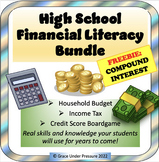Credit Score Board Game - Credit Cards, Loans, Mortgages, and Financial Literacy
- PDF
- Easel Activity
What educators are saying
Also included in
- This bundle includes my best-selling Household Budget Project that gets students thinking about income, student debt, income tax, bills, housing, transportation and more! The Credit Score Board Game teaches students how to build a strong credit score when using credit cards, student loans, mortgagesPrice $10.00Original Price $13.75Save $3.75
- Everything you need to teach your high school students about all aspects of personal finance and financial literacy in fun and visually-appealing lessons, activities, and games. These personal finance worksheets and activities cover important skills such as income taxes and tax refunds, budgeting, cPrice $18.75Original Price $26.75Save $8.00
Description
This fun, financial literacy lesson teaches students about credit scores and how to build up a good one. You can use it as a stand-alone lesson or during a personal finance unit.
Here’s how it works:
- Show your class a video to introduce the idea of credit scores: https://www.myfico.com/credit-education/what-is-a-fico-score
- Go through the two included slides and encourage students to take notes (or print a double-sided handout for each student).
- They will learn about five actions that affect credit scores: paying bills on time, how much of your credit you use regularly, how old your accounts are, having different kinds of credit, and opening new credit accounts.
- Print a game board for each group of two to four students.
- Have a six-sided die to go with each board.
- Each student needs a small item to use as a counter on the board.
- Students roll and play the game, keeping track of how their credit score rises and falls based on the realistic events on the board.
- They can use a scrap piece of paper to keep a running tally: which is great mental math practice for addition and subtraction of numbers in the hundreds!
- The winner has the highest credit score at the end of the game.
The game is designed so that students will end up with realistic credit scores (ranging between 300-850) based on the spaces they land on and the events they will experience. Some are positive (paying off bills on time) and some are negative (opening too many new credit accounts in a short period of time).
What's Included:
4 Page PDF: Ready to Print and Use!
- Teacher Instructions
- 2-Page Handout or Slideshow
- Game Board (to print for each group of players)








